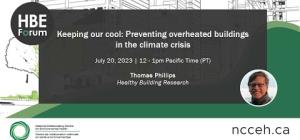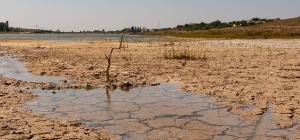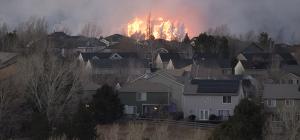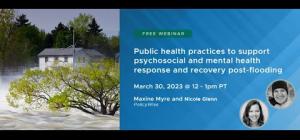
The CanDR2 Network: Improving Disaster Health Outcomes and Resilience through Data and Research

Disasters in Canada
Disasters are driven by the complex interactions of global phenomena such as extreme weather events, population growth, globalization, industrialization, urbanization, technological development, natural resource scarcity, and terrorism. Nearly all of these drivers have significant environmental public health (EPH) implications stemming from the population’s exposure to hazardous chemicals and other stressors.
Canadian communities are not immune to major EPH incidents. This is illustrated by the tragic loss of life in the 2013 Lac-Mégantic train derailment, the extensive property damage and evacuations in the 2013 Alberta floods and the 2016 Fort McMurray wildfires, and the economic and cultural disruptions of the 2016 Seaforth Channel marine diesel spill. Public health authorities who responded to these and other incidents have repeatedly expressed the need for better integration of scientific assets and methodologies to better inform both emergency response and recovery. Some of the questions raised have included:
- Can we enhance our response through more timely data collection and rigorous scientific methodologies?
- What is the distinction between a public health response and research during emergencies?
- How can we more easily leverage scientific expertise to support health authorities and emergency responders?
- What can we do to promote systematic knowledge sharing after the fact?
This blog highlights some of the issues and the joint efforts of the pan-Canadian Disaster Research Response Initiative (CanDR2) to enhance the integration of environmental public health expertise and research into disaster response and recovery. First, let’s step back to reflect on some of the challenges that public health authorities are confronted with when high-impact public health events occur.
Major Challenges Faced by EPH Practitioners
When EPH incidents strike, the initial focus is on life-saving interventions, including clinical care and minimizing population exposure. Attention then shifts to community restoration, rehabilitation, and safe re-occupancy of homes and businesses. During all of these activities, responders, remediation workers, volunteers, and residents may be exposed to a wide range of contaminants and other stressors, possibly over long periods of time, which can harm their physical and mental health.
Unlike other public health emergencies, such as disease outbreaks, EPH incidents will require both an immediate response within hours, as well as a longer-term response that may stretch over years. As these complex effects unfold over time, taking an organized, pro-active approach to learning—through a well-defined and data-driven investigation—is invaluable to identifying the delayed and long-term health effects and improving both health outcomes and future response capabilities. However, there is typically a very brief window of time in which to lay the groundwork for an investigation and capture time-sensitive exposure data and biospecimens (if deemed valuable).
A second and more basic challenge is knowing when or whether such an investigation, which diverts resources from other critical activities, would be of value to the community impacted. The decision to launch an investigation depends on expert-level knowledge of the exposure and how the population is likely to respond. This calls for a multi-disciplinary team of exposure scientists, field epidemiologists, medical toxicologists, and toxicology laboratories to be better integrated into emergency response structures to assist public health authorities. Their expertise can inform the identification and characterization of toxicological hazards, the estimation of exposures, and the approach for monitoring long-term health effects. Further, scientific expertise is useful to assist with designing follow-up surveys and evaluating the need for biological sampling for toxicology analysis. However, while such expertise exists across sectors and jurisdictions, there is no comprehensive pan-Canadian framework to provide mutual support in times of need.
The CanDR2: Integrating Scientific Assets into Public Health Emergency Response
In 2016, a CIHR-funded Best Brains Exchange brought together a group of public health and other emergency response experts to discuss the barriers and opportunities for better integrating scientific assets into emergency response. This meeting (described here in detail) laid the groundwork for the pan-Canadian Disaster Research Response (CanDR2) initiative, driven by an interdisciplinary group of public health practitioners, health researchers, emergency management specialists, environmental health scientists and knowledge translators. The CanDR2 draws upon the US National Institutes of Health Disaster Research Response Program, a framework aimed at enhancing the integration of EPH scientific and research assets into disaster management. Our partners include Alberta Health, BC Centre for Disease Control, Health Canada, Japan National Institute for Environmental Health Studies, Public Health Agency of Canada (PHAC), Public Health Ontario, Santé et Services Sociaux du Québec, Health Canada-PHAC Research Ethics Board and the US National Institute of Environmental Health Sciences.
The aim of the CanDR2 is to first foster a collaborative environment, drawing in experienced EPH emergency responders from Canadian disasters and abroad. Through this joint effort, we are developing a Canadian EPH response framework based on the following three overlapping areas of focus:
- Establishing an EPH disaster response community of practice;
- Generating and transferring EPH disaster knowledge; and
- Enhancing timely data sharing, sample collection, and health research.
Our current activities include a historical overview of research in Canadian disasters (a literature review), the development of response and research toolkits to empower public health practitioners and researchers, and the exploration of mechanisms to expedite research ethics reviews, oversight, and approval for human studies. In the long-term, the establishment of a community of practice will aid in accessing scientific expertise and knowledge sharing.
The CanDR2 is supported by the Canadian Network for Public Health Intelligence informatics (CNPHI), a secure scientific public health informatics and biosurveillance platform, which is administered by the National Microbiology Laboratory (NML) within PHAC. CNPHI’s mission is to foster collaboration and consultation through innovation in disease surveillance, intelligence exchange, research and response, to protect, promote and support public health. This platform will be critical to bring together a community of practice in a secure and confidential virtual space.
The CanDR2 also works in close partnership with the National Collaborating Centre for Environmental Health (NCCEH), which assists in the development of EPH response tools and knowledge translation. One fruit of this partnership is Health Canada’s Guidance for the Environmental Public Health Management of Crude Oil Incidents, which drew heavily on past experiences in Canadian incidents. The NCCEH has also uses its national platform to share information through its Environmental Health Seminar Series. On Oct 2nd, 2019, NCCEH and Health Canada will co-host a webinar by Dr. Richard Kwok and his experiences with disaster research during the Deepwater Horizon oil (register here). A recording of this webinar will be made available on YouTube via our NCCEH channel.
Disasters come not “if” but “when”. When they do happen, our duty of care to the public calls for increased multi-disciplinary collaboration to address community health concerns and to generate resilience-building knowledge through the judicious deployment of scientific investigations during response and recovery. Making this happen will require relationship- and capacity-building within and across levels of government and with the academic community. By creating a collaborative space and capacity-enhancing tools and products, the CanDR2 hopes to address these knowledge gaps and empower public health to make best use of our scientific resources.
Have you previously responded to an EPH incident in your community, or are you looking to prepare for future events? Do you want to share your experience or research endeavors? If so, please get in touch with [email protected].








